Books by James D. Watson Published by Cold Spring Harbor Laboratory Press
Father to Son: Truth, Reason, and Decency
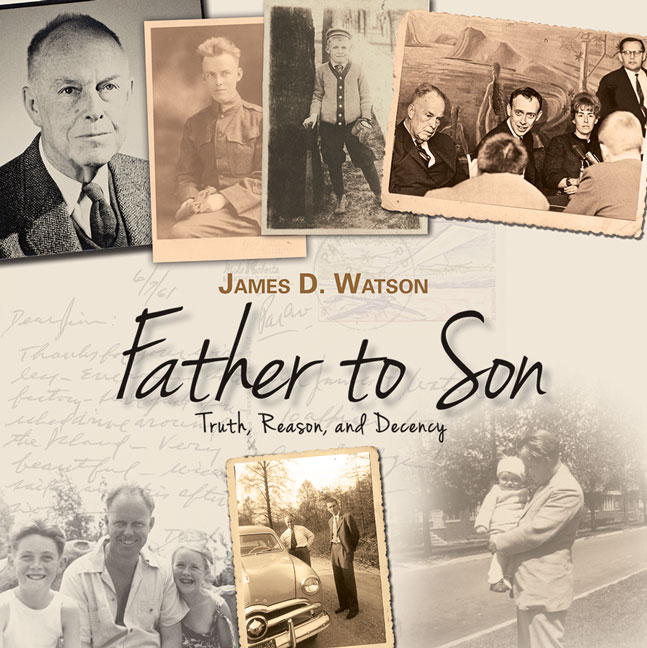 At the age of 24, James Watson had a scientific discovery to his credit—the structure of DNA—that would win a Nobel Prize and forever change our understanding of genes and inheritance. Now, after a lifetime of accomplishment in research, writing, education, and science advocacy, Watson has delved for the first time publicly into his own lineage to chronicle an archetypical American family from before the Civil War to Vietnam. With its portraits of many memorable characters, illustrated with previously unpublished photographs and period documents, Father To Son brilliantly illuminates the fundamental truth that who we become as individuals is determined by both our genetic and cultural heritage.
At the age of 24, James Watson had a scientific discovery to his credit—the structure of DNA—that would win a Nobel Prize and forever change our understanding of genes and inheritance. Now, after a lifetime of accomplishment in research, writing, education, and science advocacy, Watson has delved for the first time publicly into his own lineage to chronicle an archetypical American family from before the Civil War to Vietnam. With its portraits of many memorable characters, illustrated with previously unpublished photographs and period documents, Father To Son brilliantly illuminates the fundamental truth that who we become as individuals is determined by both our genetic and cultural heritage.
Molecular Biology of the Gene, Seventh Edition
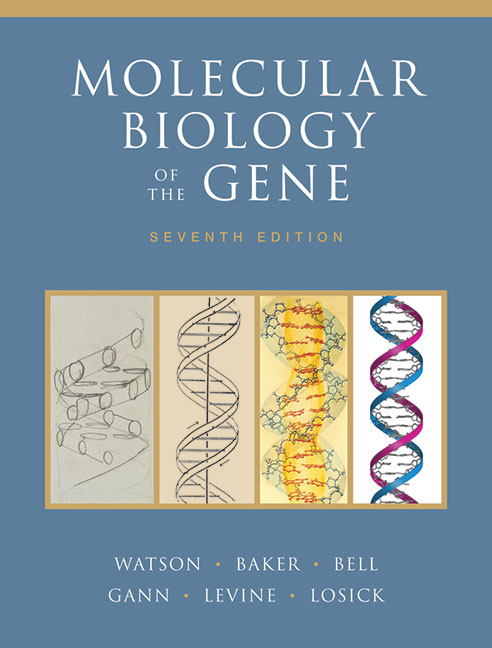 Now completely up-to-date with the latest research advances, the Seventh Edition of James D. Watson’s classic book, Molecular Biology of the Gene retains the distinctive character of earlier editions that has made it the most widely used book in molecular biology. Twenty-two concise chapters, co-authored by six highly distinguished biologists, provide current, authoritative coverage of an exciting, fast-changing discipline.
Now completely up-to-date with the latest research advances, the Seventh Edition of James D. Watson’s classic book, Molecular Biology of the Gene retains the distinctive character of earlier editions that has made it the most widely used book in molecular biology. Twenty-two concise chapters, co-authored by six highly distinguished biologists, provide current, authoritative coverage of an exciting, fast-changing discipline.
The Annotated and Illustrated Double Helix
The structure of DNA deduced by James Watson and Francis Crick in 1953 was one of the most significant scientific discoveries of the 20th century. Fifteen years later, Watson wrote The Double Helix, his classic account of the discovery. It was something new, a description of science in action written not as a formal autobiography or a measured history, but in the voice of a brash, ambitious young man who knew the big question in biology and wanted the answer.
In this edition, Watson’s text is unchanged, but Alex Gann and Jan Witkowski have added over three hundred annotations on the events and characters portrayed, with facsimile letters and contemporary photographs, many previously unpublished. Their sources include newly discovered correspondence from Crick, the papers of Franklin, Pauling, and Wilkins, and they include a chapter dropped from the original edition.
The Double Helix is recognized by the Library of Congress as “A Book That Shaped America”. This new edition, published to mark the 50th anniversary of the Nobel Prize for Watson, Crick, and Wilkins, and the 60th anniversary of the discovery itself, adds depth and richness to one of the most famous stories in science.
“The Double Helix is the best book I know about a scientific discovery-this new edition suffuses the whole with social history, fascinating documentation, photography, and cunning background research. The early fifties, the beginning of the modern age of molecular biology, spring to life.“ —Ian McEwan, author of Atonement
“The Double Helix is an extraordinary book: a thrilling, novelistic account of one of the most surprising of all scientific discoveries. This new edition draws upon a remarkable and eclectic archive of information to bring to life the stories of those who found the secret of life.“ — Matt Ridley, author of Genome and Francis Crick
Recombinant DNA: Genes and Genomes - A Short Course
Third Edition
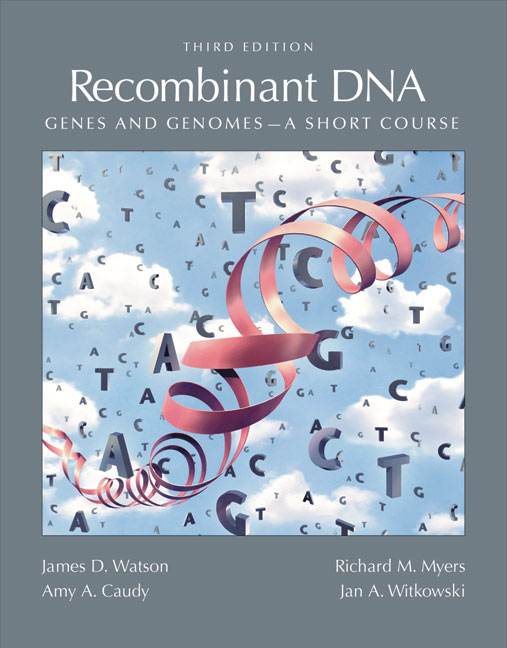 The third edition of the landmark text Recombinant DNA offers an authoritative, accessible, and engaging introduction to modern, genome–centered biology from its foremost practitioners. The new edition explores core concepts in molecular biology in a contemporary inquiry–based context, building its coverage around the most relevant and exciting examples of current research and landmark experiments that redefined our understanding of DNA. As a result, students learn in a compelling way how working scientists make real high–impact discoveries.
The third edition of the landmark text Recombinant DNA offers an authoritative, accessible, and engaging introduction to modern, genome–centered biology from its foremost practitioners. The new edition explores core concepts in molecular biology in a contemporary inquiry–based context, building its coverage around the most relevant and exciting examples of current research and landmark experiments that redefined our understanding of DNA. As a result, students learn in a compelling way how working scientists make real high–impact discoveries.
The first chapters provide an introduction to the fundamental concepts of genetics and genomics, an inside look at the Human Genome Project, bioinformatic and experimental techniques for large–scale genomic studies, and a survey of epigenetics and RNA interference. The final chapters cover the quest to identify disease–causing genes, the genetic basis of cancer, and DNA fingerprinting and forensics. In these chapters the authors provide examples of practical applications in human medicine, and discuss the future of human genetics and genomics projects.
Genes, Girls, and Gamow: After the Double Helix
 FROM THE PUBLISHER (Alfred A. Knopf): Immediately following the revolutionary discovery of the structure of DNA by James D. Watson and Francis Crick in 1953, the world of molecular biology was caught up in a gold rush. The goal: to uncover the secrets of life that the newly elucidated molecule promised to reveal. Genes, Girls, and Gamow is James Watson's report on the amazing aftermath of the DNA breakthrough, picking up where his now classic memoir, The Double Helix, leaves off.
FROM THE PUBLISHER (Alfred A. Knopf): Immediately following the revolutionary discovery of the structure of DNA by James D. Watson and Francis Crick in 1953, the world of molecular biology was caught up in a gold rush. The goal: to uncover the secrets of life that the newly elucidated molecule promised to reveal. Genes, Girls, and Gamow is James Watson's report on the amazing aftermath of the DNA breakthrough, picking up where his now classic memoir, The Double Helix, leaves off.
Here are the collaborations and collisions of giants, not only Watson and Crick themselves, but also legions of others, including Linus Pauling (the greatest chemist of the day), Richard Feynman (the bongo–playing cynosure of Caltech), and especially George Gamow, the bearlike, whiskey–wielding Russian physicist, who had turned his formidable intellect to the field of genetics; with Gamow—an irrepressible prankster to boot—Watson would found the legendary RNA Tie Club.
But Watson—at twenty–five already the winner of genetic research's greatest jackpot—is obsessed with another goal as well: to find love, and a wife equal to his unexpected fame. As he and an international cast of roguish young colleagues do important research they also compare notes and share complaints on the scarcity of eligible mates. And amid the feverish search for the role of the then still mysterious RNA molecule, Watson's thoughts are seldom far from the supreme object of his desire, an enthralling Swarthmore coed who also happens to be the daughter of Harvard's most eminent biologist.
Part scientific apprenticeship, part sentimental education, Genes, Girls, and Gamow is a penetrating revelation of how great science is accomplished. It is also a charmingly candid account of one young man's full range of ambitions.
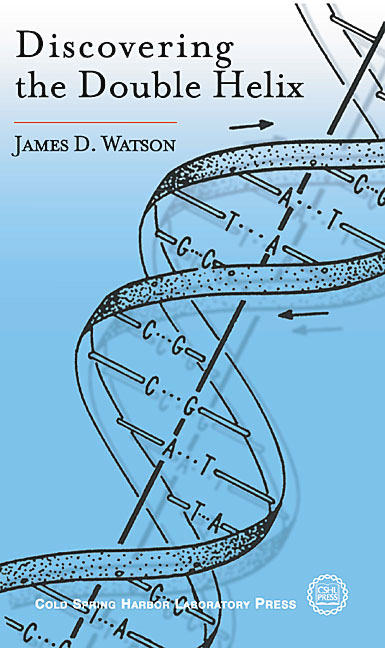 The structure of DNA proposed by James Watson and Francis Crick in 1953 was one of the most important scientific discoveries of the twentieth century, transforming biology, giving medicine new impetus, and providing a foundation for the new industry of biotechnology. Jim Watson's best-selling memoir of the events leading to this discovery, The Double Helix, has enthralled millions of readers since its publication in 1968. In this videotaped lecture, recorded live at Cold Spring Harbor Laboratory in November 1999, Dr. Watson retraces those events in a very personal reminiscence of the period and the people involved. This is an account of one of the great dramas of science, told from the intimate perspective of a participant who, aged 25 at the time of the discovery, has become one of the intellectual leaders of our time.
The structure of DNA proposed by James Watson and Francis Crick in 1953 was one of the most important scientific discoveries of the twentieth century, transforming biology, giving medicine new impetus, and providing a foundation for the new industry of biotechnology. Jim Watson's best-selling memoir of the events leading to this discovery, The Double Helix, has enthralled millions of readers since its publication in 1968. In this videotaped lecture, recorded live at Cold Spring Harbor Laboratory in November 1999, Dr. Watson retraces those events in a very personal reminiscence of the period and the people involved. This is an account of one of the great dramas of science, told from the intimate perspective of a participant who, aged 25 at the time of the discovery, has become one of the intellectual leaders of our time.
James D. Watson was Director of Cold Spring Harbor Laboratory, New York, from 1968 to 1993 and is now its President. He was the first Director of the National Center for Human Genome Research of the National Institutes of Health from 1989 to 1992.
Dr. Watson is a member of the National Academy of Sciences and Royal Society and has received many awards and honors, including the Presidential Medal of Freedom and the National Medal of Science. In addition to The Double Helix, his books include Molecular Biology of the Gene, Molecular Biology of the Cell, Recombinant DNA, and A Passion for DNA.
A Passion for DNA: Genes, Genomes, and Society
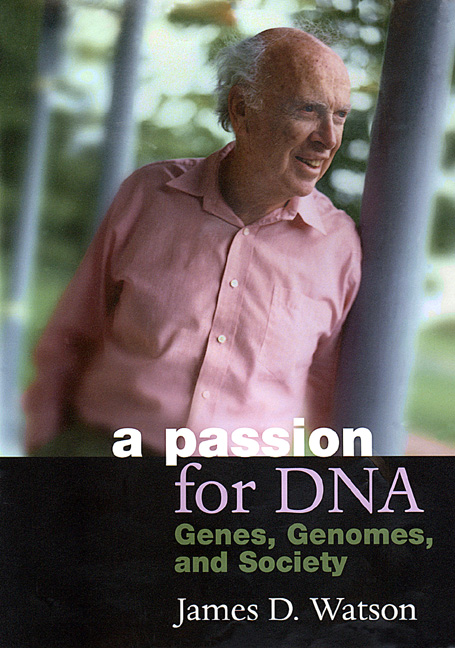 Jim Watson is one of the world's most famous scientists. A principal architect and visionary of modern biology, a Nobel Prize winner at 34, and best selling author at 40 (The Double Helix), he has been a fearless commentator on the march of DNA science and its impact on society for over twenty years.
This sparkling collection was a best seller in hardcover, and, for the paperback edition, the author has added three newly written essays containing his reflections on the survival value of pursuing happiness, advice for new college graduates, and his thoughts on the completion of a draft of the human genome, a project he initiated over ten years ago.
Jim Watson is one of the world's most famous scientists. A principal architect and visionary of modern biology, a Nobel Prize winner at 34, and best selling author at 40 (The Double Helix), he has been a fearless commentator on the march of DNA science and its impact on society for over twenty years.
This sparkling collection was a best seller in hardcover, and, for the paperback edition, the author has added three newly written essays containing his reflections on the survival value of pursuing happiness, advice for new college graduates, and his thoughts on the completion of a draft of the human genome, a project he initiated over ten years ago.


